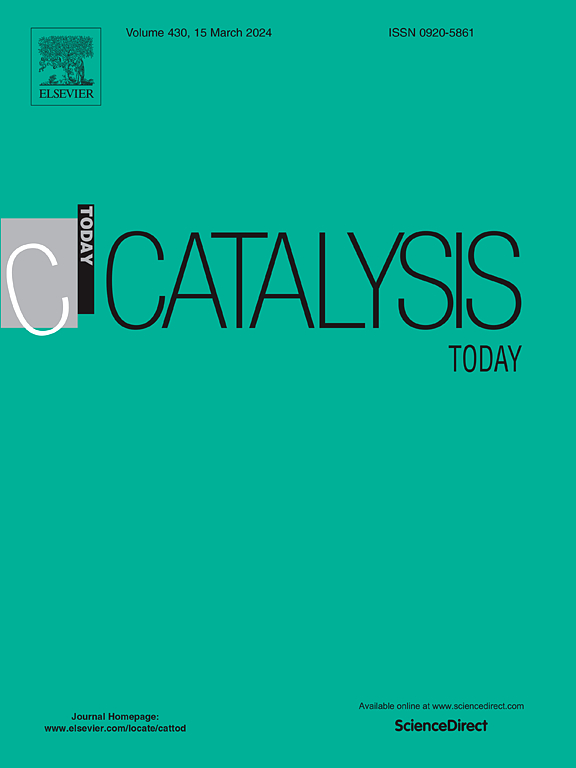Progress and perspective on the fundamental understanding of structure–activity/selectivity relationships for Ag catalyzed ethylene epoxidation
IF 5.2
2区 化学
Q1 CHEMISTRY, APPLIED
引用次数: 0
Abstract
Ethylene oxide (EO) stands among the most pivotal gateway chemicals where Ag-catalyzed ethylene epoxidation is the only viable route in the chemical industry. Academically, it is also one of the most attractive model reactions that involves advancements of multiple disciplines in catalysis science. Over the past decades, a list of classic fundamental questions have emerged that sparked extensive debates regarding i) nature of selective oxygen species; ii) state of the silver surface layer under reaction condition, iii) detailed reaction mechanism of ethylene epoxidation, etc. In this contribution, we critically review what has been achieved to date on the understandings of the molecular structure – activity relationship for silver-catalyzed ethylene oxidation. We first highlight how cutting-edge in situ/operando spectroscopic characterization techniques played a unique role in deciphering the catalytic structure of the silver catalyst under working conditions. Next, we provide a strategic summary on the means of maneuvering the activity and EO selectivity over supported Ag/α-Al2O3 catalysts, including particle size manipulation, crystal phase engineering, silver oxidation state and support management. The review ends with a perspective on the computational insights into the kinetics and mechanism of Ag-catalyzed ethylene epoxidation. We hope that the developments and methodologies highlighted in this review will not only help academia and industry to further the fundamental understanding and commercial development of silver-based catalysts for ethylene epoxidation, but also inspire revolutionary breakthroughs in other heterogeneous catalysis applications.
银催化乙烯环氧化结构-活性/选择性关系基本认识的进展与展望
环氧乙烷(EO)是最重要的门类化学品之一,在化学工业中,Ag 催化乙烯环氧化反应是唯一可行的途径。在学术上,它也是最具吸引力的模型反应之一,涉及催化科学多个学科的发展。在过去的几十年中,出现了一系列经典的基本问题,引发了广泛的争论:i) 选择性氧物种的性质;ii) 反应条件下银表面层的状态;iii) 乙烯环氧化的详细反应机理等。在这篇论文中,我们对迄今为止在理解银催化乙烯氧化的分子结构-活性关系方面所取得的成就进行了批判性回顾。我们首先强调了最先进的原位/操作光谱表征技术如何在破译银催化剂在工作条件下的催化结构方面发挥了独特的作用。接下来,我们从战略角度总结了在支撑型 Ag/α-Al2O3 催化剂上提高活性和环氧乙烷选择性的方法,包括粒度控制、晶相工程、银氧化态和支撑管理。在综述的最后,我们从计算角度深入探讨了银催化乙烯环氧化的动力学和机理。我们希望这篇综述所强调的发展和方法不仅能帮助学术界和工业界进一步加深对乙烯环氧化银基催化剂的基础理解和商业开发,还能在其他异相催化应用领域带来革命性的突破。
本文章由计算机程序翻译,如有差异,请以英文原文为准。
求助全文
约1分钟内获得全文
求助全文
来源期刊

Catalysis Today
化学-工程:化工
CiteScore
11.50
自引率
3.80%
发文量
573
审稿时长
2.9 months
期刊介绍:
Catalysis Today focuses on the rapid publication of original invited papers devoted to currently important topics in catalysis and related subjects. The journal only publishes special issues (Proposing a Catalysis Today Special Issue), each of which is supervised by Guest Editors who recruit individual papers and oversee the peer review process. Catalysis Today offers researchers in the field of catalysis in-depth overviews of topical issues.
Both fundamental and applied aspects of catalysis are covered. Subjects such as catalysis of immobilized organometallic and biocatalytic systems are welcome. Subjects related to catalysis such as experimental techniques, adsorption, process technology, synthesis, in situ characterization, computational, theoretical modeling, imaging and others are included if there is a clear relationship to catalysis.
 求助内容:
求助内容: 应助结果提醒方式:
应助结果提醒方式:


